I've always been a writer. In 3rd grade [1976]
I was thrown outside class for some reason and was sitting
on a bench, probably frowning inside over Ms. Kingo who was
my teacher and my daemon. Few minutes later a guy from the
other 3rd grade class arrived at the same bench for the same
reason. His name was Mogens Gårdsmann.
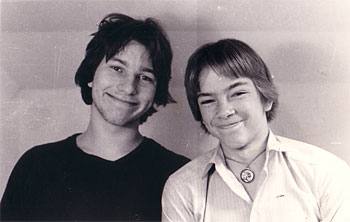
Mogens Gårdsmann and Thorsten Overgaard (promotional
photo 1981)
I was
writing on a magazine with jokes at that time that I wanted
to publish, and Mogens Gårdsmann who sat next to me
turned out to be good with drawings. So we made a joint venture
right there and few months later our first magazine, Lattermedicin
[Laughter Medicine], was published and sold in local kiosks
and comics stores. It had developed from the original idea
so that it also contained 4 pages with a comic we had done
together, "Rin tin tin."
We did
a magazine number two also but as we had now learned all the
mechanics about typesetting, printing, distribution and so
on, it was down to normal boring business - and didn't look
like becoming a prosperous business either.
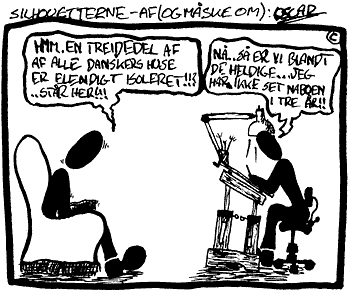
One of Thorstens work under the name Oscar
We had
developed an interest for comics. So instead of publishing
more magazines we turned to comics production in my room at
my mothers house (because I had a drawing table). The work
would normally be performed in the way that we would joke
around verbally and physically like in a cartoon, mocking
up figures and stories, agree to some sort of story board
and then rush to the drawing table where I would draw up the
frames for the pages which Mogens would then make pencil drawings
in, whereafter I would ink the drawings and write the text
nicely and readable.
The major
problem in comics is that it is lengthy work to get something
produced! To give an idea on how lengthy a process it is:
The pencil drawings on the page might have taken 1 to 2 days
for Mogens to do and then it would take me 2-4 days to ink
them and finish it. Sometimes even more as we developed all
sorts of fancy techniques with markers, Letraset dots and
so on.
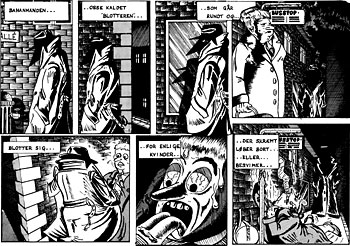
Another
thing is that it is also nice to play chess and to mock up
new stories and jokes. And when you have the story, all there
is left is to get the work done. And that is the hard part.
It is fun in the way that it is a developing process where
you get better and better in what you do, and that you really
ARE your characters and the buildings and such that you draw.
So we spent a lot of time BEING the paper, the ink, the persons,
the cars, the chairs and such that we were drawing. We had
our own little universe going there.
However,
the whole process is so developing that when you would work
on a 48 page album, you would look back after finishing page
8 - and then you wanted to redo the first pages because the
last two pages looked so much better than the first ones.
Both the characters, the story and the technical aspects.
And we
had so many ideas why we would normally then skip the whole
project for "later" and start on a whole new one...
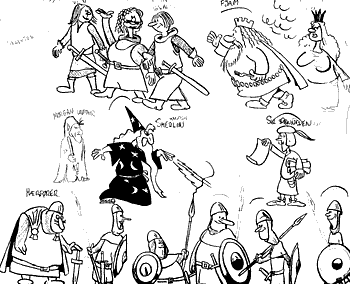
Casting draft for the persons in comic stripes...
One day
Mogens came up with a bright idea: If we do comic stripes
we would be able to work on several types of series simoustanely
and also get to actually finish some stripes. So we did that
and actually got a lot of things finished. We had a doctor
series, a musketeer series, a stoneage series and some others.
Getting
it published was another story. The comics scene was a bit
suppressed at that time. There was a lot of French, Belgium
and American comics being translated into Danish and published
but very few Danish. Actually at that time most comics was
stripes such as "Poeten & Lillemor" by Jørgen
Mogensen, "Alfredo" by Cosper Cornelius (who's Granddaughter,
Charlotte, I was funny enough married to for 12 years from
1990 to 2002) and few others. Those comics was running in
newspapers and weekly magazines for women so from our viewpoint
our work wasn't even vaguely related to it.
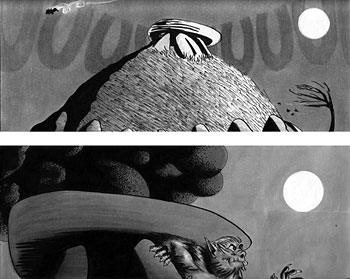
Comic made with grey tones using Pantone markers ...
There
was also being developing a major project to produce a Danish
comics, VALHALLA that could be the Danish Tin Tin or Asterix.
It was a project initiated by the Danish publishing house
Interpresse who found the people to produce the comic which
one of their own editors was writing. The key figure in this
project was Peter Madsen who was the first "real"
Danish comics drawer to make a living of drawing comics.
From about
1980 and onward this project was the forefront of the Danish
comic world and opened up a Golden Age that lasted till about
1987 (when most comics became more or less adult comics in
the semi-pornographic sense).
Anyhow,
we - or especially I - made it a game to get things published.
We made a magazine for the 3 publishers in Denmark where the
tone was harsh and we were teasing them that they should open
their eyes on our work and publish it. The wrong thing about
this was that we had never spoken to them. So to open up the
communication by insulting them maybe wasn't as smart as it
was sure fun to do. We never got anything published there!
Newer! They didn't even write us a letter.
Instead
we got some comic stripes published (and actually paid very
well) in a Scandinavian magazine that was published from Lund
in Sweden. It came out in Finland, Norway, Sweden and Denmark.
The name of it was "Super" and it was mostly a rip-off
of MAD.
We also
got some works published in the "Hård Kost 2"
which was an underground album publication done by some weird
longhaired people who lived together in the same apartment
and shared a water pipe...
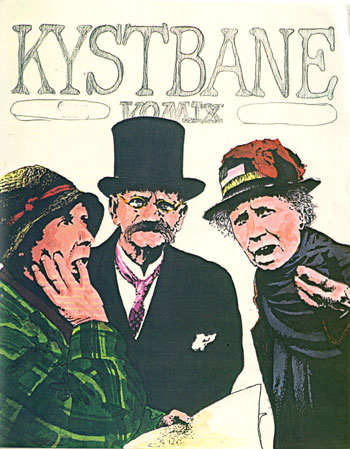
Dummy frontpage by Thorsten for a danish comic magazine...
In 1982
a young guy (17 years), Johnny Heinmann, started a publishing
house with three of his school friends. They were to publish
the magazine "Danske Tegneserier" [Danish Comics]
that would contain work of Danish comics drawers only. We
got into this project from the beginning and had some pages
in each issue.
The truth
of the matter was however that we were school kids then and
didn't pay much interest to the business side of it. We had
a crack making the comics and that then was what we concentrated
on. We also got to play a lot of chess in-between, smoked
pipe at that time (we weren't allowed to smoke cigarettes
by our parents so we never did ;-).
Hjelm
Påbudt
From 1980 we called out teamwork "Tegnebordet 80"
[The Drawing Table 80] - somehow the concept of making companies
was in the blood already then.
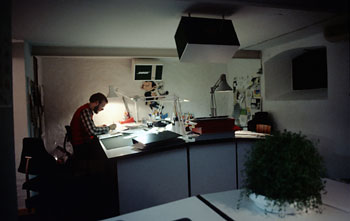
We were
pretty much alone with our interest it seemed. There was a
comics drawing office in Copenhagen called Gimle where 5 people
worked. Some of them full-time doing Donald Duck and other
work that you could make a living of, and one of them had
published his own albums at that time. The VALHALLA project
was also done at this studio.
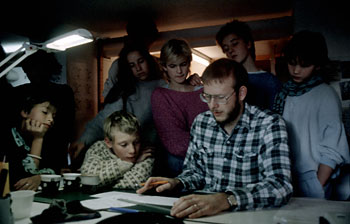
Lars Dahl teaching a visiting school class ablout comics
making in Hjelm Påbudt ...
So we
got the idea to make a comics drawing office in Århus
where we could get like-minded people to come and work, as
well as making it a place for comic fans to hang out. Probably
via the "HÅRD KOST" network we got Lars Dahl,
Ole Okkels and Peter to join us in renovating my mothers cellar
from 1872 into a drawing office. As there was only 174 cm.
to the ceiling the name for it was to be "Hjelm Påbudt"
[Wear a helmet]. We would be sitting down anyway!
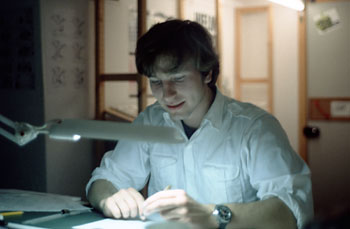
Mogens Gårdsmann in Hjelm Påbudt
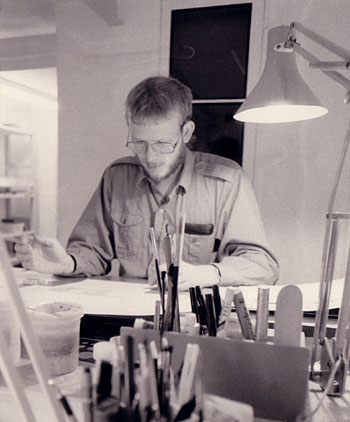
Lars Dahl in Hjelm Påbudt, 1984
So we
opened up the "Hjelm Påbudt" and in a matter
of few months we were a hard-core group of Mogens, Lars Dahl
and I making comics in the evenings and every Sunday. The
Sunday was mandatory, the other days could vary. Lars was
in the mid-twenties then while we were still teenagers. So
he learned us to love Genesis, Lou Reed and other adult music
we had else not been in touch with. We worked in silence,
listening to the music, sometimes talking and joking while
doing our thing and drank a lot of coffee.

Pierre Christin (text) and Jean-Claude Mézieres (drawing)
who is known for their Linda & Valentin comics
visited Hjelm Påbudt in 1986.On this picture they are
surrounded by Lars Dahl, Poul Petersen (comic drawer from
Sønderjylland) and Mogens Gårdsmann. There was
also some journalists and photographers in the background.

Mézieres, Mogens and Lars discussing techniques ...
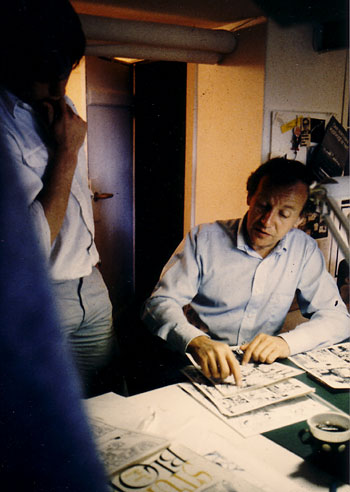
Mézieres and Mogens talking page flow ...
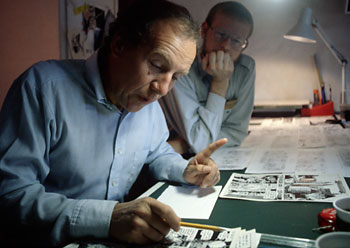
Mézieres
and Lars ...

Poul Pedersen and Lars Dahl sharing a "Matador Mix"
and discussing techniques...
Blitz
and the advertising agency
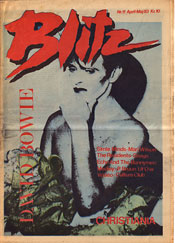 I was also soon into writing articles about comics in the
monthly magazine on sub-culture, Blitz. I took over the comics
editor posts at one stage and then also edited four pages
of danish comics every month, did interviews with comics drawers
such as Runt T. Kidde, Peter Madsen, publishers and so on.
And also wrote articles on the technical aspects of making
comics (tools guides, how to, etc.).
I was also soon into writing articles about comics in the
monthly magazine on sub-culture, Blitz. I took over the comics
editor posts at one stage and then also edited four pages
of danish comics every month, did interviews with comics drawers
such as Runt T. Kidde, Peter Madsen, publishers and so on.
And also wrote articles on the technical aspects of making
comics (tools guides, how to, etc.).
I was
then in 10th grade in school and later in business school
and would mostly rush home in the mid day break to check my
mail for new comics from the publishing houses for review,
original comics from drawers and other stuff. I got everything
that was being published sent to me for free in that period
which added somewhat three meters of comics to my collection.
Call it
destiny. Once I did an interview on a person who had been
the driving force in the Danish comics world in the 70ties.
One day he just stopped talking to the people he used to in
the comics world, stopped buying and reading comics, and instead
started running an organization for bicycle interests. I thought
of it like treason at that time, probably around 1983. I was
really upset by the fact that someone could just turn around
like that!
In 1985
Mogens and I had finished our school and was about to finish
our educations. He was a buildings painter, I was working
on a timbermill. Both trades far from what we had expected
in life. So we talked about this and decided that we wanted
a future that was fun, easy and prosperous. And as we couldn't
live of making comics, we decided advertising was it. So in
September 1985 we started "A-Z reklame" [A-Z advertising]
in the same cellar where the "Hjelm Påbudt"
was, and added a darkroom in the building next door.
After
just three months Mogens confessed that he didn't like the
advertising business - it was to few drawings and to much
business. In half an hour we had decided that I would take
over the company and he was free to leave.
And from
that moment I actually skipped reading comics, making them,
writing about them - and was out of that world. Just like
the guy I had written about few years earlier and whom I thought
of as a treasoner. Call it destiny. It was the end of "my
secret life."
I wasn't
mad at anybody or such. I just had enough work doing advertising
and probably that work fulfilled my interst for working with
ideas and graphic elements.
Epilogue:
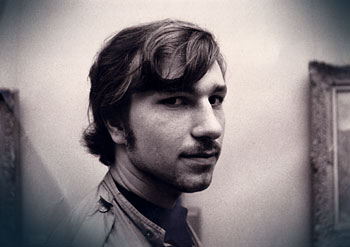
Mogens Gårdsmann (1965-)worked on several advertising agencies
in town for some years and ended up with his own drawing office www.gills.dk
where he did airbrush illustrations and the like on computer
for somewhat 5 years. All the time he made comics on the side
and got some published. In the end of the 90'ties he divorsed
from his Norwegian wife and moved to Australia where his brother
had been living for the last ten or fifteen years, but returned to Aarhus and Herning in Denmark and worked for LEGO with animations and illustrations.
Lars
Dahl continued his day job at Tele Denmark working with
EDB and continued with comics as well. He has gotten albums
published and wil probably get more published in the coming
years. You can read more about him at www.tegneseriemuseet.dk/bio/art_dahl.htm
Johnny
Heinmann (1965-)closed down the publication
"Danske Tegneserier" with a heavy loss and then
started publishing of traditional books and childrens books
untill 1987 when he came and started working with me in the
advertising agency and a publishing house I had started also.
Since 1990 he has been building a successfull market analysis
company, Analysegruppen A/S in Silkeborg, Denmark. [ www.analysegruppen.dk
] and also entered politics.
Morten Hesseldahl (1965-)went on with a career in culture, as a writer, CEO of the Danish newspaper Information, chairman of the board of The Danish Film Institute, member of the DR executive branch (Danish national television), CEO of The Roal Theathre in Copenhagen and CEO of the Danish publishing house Gyldendal.
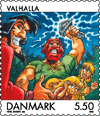 Peter
Madsen (1958-) who worked on the VALHALLA finished his education
as a doctor and moved to Silkeborg where he practice as a
doctor most of the time. He still draws from time to time
(did one of my christmas cards for the advertising company
one year). Valhalla has been made into a movie and official
Danish stamps (as seen at the right). You can read more about
him at https://www.tegneseriemuseet.dk/bio/art_madsen_pet.htm
Peter
Madsen (1958-) who worked on the VALHALLA finished his education
as a doctor and moved to Silkeborg where he practice as a
doctor most of the time. He still draws from time to time
(did one of my christmas cards for the advertising company
one year). Valhalla has been made into a movie and official
Danish stamps (as seen at the right). You can read more about
him at https://www.tegneseriemuseet.dk/bio/art_madsen_pet.htm
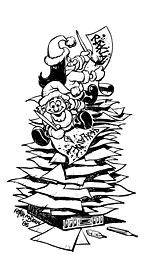
Peter
Madsen did this drawing for my christmas cards in 1986.
 Henrik
Rehr (1964-), who worked closely with Johnny Heinmann on "Danske
Tegneserier" back in the 80ties, today lives on Manhatten
with his wife and their kids. He did a comic, "TUESDAY,"
about September 11 as he lives just next to and experienced
it first hand. And then he has been doing the comic strip
Ferdinand which he took over some years ago after that Ferdinands
"father" died. He also paint and have held several
exhibitions.
Henrik
Rehr (1964-), who worked closely with Johnny Heinmann on "Danske
Tegneserier" back in the 80ties, today lives on Manhatten
with his wife and their kids. He did a comic, "TUESDAY,"
about September 11 as he lives just next to and experienced
it first hand. And then he has been doing the comic strip
Ferdinand which he took over some years ago after that Ferdinands
"father" died. He also paint and have held several
exhibitions.
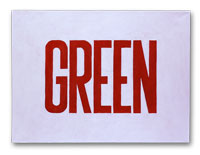
Henrik Rehr's painting "Green"
Peter Maltha Continued as illustrator and painter.
Thorsten Overgaard (1965-) continued with advertising after the Hjelm Påbudt and into dot.com from 1995. In 2000 he sold his business to Execon and became an investor, writer and pohotographer, traveling around the world to more than 25 counties a year. He eventually moved out of Denmark and lives between Hong Kong and USA with his American wife, recording artist Joy Villa.
- Thorsten
Overgaard, Lido de Spina, Italy, July 2002.
Last edited September 2018.
![]()
